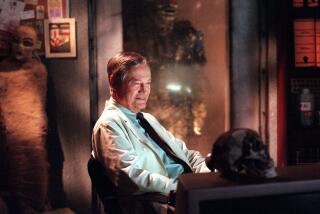BOOK REVIEW / BIOGRAPHY : Fresh Look at Director George Cukor Doesn’t Reveal All : GEORGE CUKOR / Master of Elegance <i> by Emanuel Levy</i> ; Morrow $25, 400 pages
- Share via
Emanuel Levy has written a meticulously researched and gently revisionist biography of the esteemed but controversial director George Cukor, attempting to capture the particular vision that gave a Cukor film its unique qualities.
The author has also set out to alter “some of the prevalent myths and long-held notions about Cukor as an artist and a man,” believing that previous biographers have perpetuated the idea that Cukor’s films tended to be overly static and confined and that he was replaced as director of “Gone With the Wind” because Clark Gable found working with him impossible and resented his attention to Vivien Leigh.
By exploring and investigating all of the complex circumstances surrounding these questions in “George Cukor: Master of Elegance,” Levy offers a fresh and different take upon the perceived wisdom, one that should be of considerable interest to film historians.
When he confronts the issue of Cukor’s homosexuality and the effect of that sensibility on Cukor’s work, Levy is less persuasive, finding excessive significance in the fact that most of Cukor’s films had “strong, eccentric heroines, outsiders who wished to assimilate but without giving up their idiosyncratic habits and traits--just like him.”
Though such heroines do appear in some Cukor films, and he is well-remembered for “The Philadelphia Story” and “Holiday,” he also directed a wide variety of pictures in which resemblances between the director and the heroine are faint to nonexistent.
When you consider that Cukor was also responsible for “Little Women,” “David Copperfield,” “Romeo and Juliet,” “A Star Is Born,” “Gaslight” and “A Double Life,” the hypothesis, shaky at best, quickly begins to crumble.
In any case, Cukor was not the author of any of the scripts in question, though he may have taken particular pleasure in choosing and directing stories with spirited female characters.
The 1930s and ‘40s were the heyday of witty, willful and often rebellious movie heroines, winsome types who went into sad eclipse in the following decades, supplanted by more passive and far less vivacious characters.
Instead of dimming during this later era, Cukor’s own star seems to have blazed even more brightly, and he did much of his most memorable work in the 1950s.
Quoting lavish praise of “A Star Is Born,” Levy says, “(The film) showed of Cukor’s multiple skills as politician, statesman, psychiatrist, magician, painter, writer, animal trainer, nurse, elocutionist, dancer, mathematician, musician, cameraman, dressmaker --everything but Garland’s husband.”
Though Levy makes a strenuous effort to present a fully realized portrait of the man as well as the work, like the biographers who preceded him, he tends to be stymied by Cukor’s extreme reticence about his private life. There are descriptions of Cukor’s lavish luncheon and dinner parties, events characterized for remarkable food and indifferent wine.
An abstemious chap, Cukor allowed his guests a single drink before dinner, and seemed totally oblivious to the beverages that accompanied the exquisite meals, though his taste in other aesthetic matters was flawless.
His house, an ongoing project, was filled with splendid antiques and extraordinary contemporary art.
A perfect, if somewhat affected, gentleman in virtually every respect, Cukor apparently dropped that facade only on the set, where he allowed himself to be amazingly profane, particularly when his suggestions were contested.
Levy interviewed scores of actors in writing the book, most of whom remember Cukor with respect and admiration.
The few who are less laudatory--Stewart Granger, Anouk Aimee, Jacqueline Bisset--add welcome vitality to what might have otherwise been merely homage to an unusually long and distinguished career spanning half a century.
Although Levy shows Cukor the director to have been far more versatile than prior books suggest, ultimately Cukor’s extreme discretion about other matters turns even this definitive study into an extended professional resume.
The human being responsible for the polished gestures, the subtle interplay and the sophisticated interpretations remains an elusive presence.
More to Read
Only good movies
Get the Indie Focus newsletter, Mark Olsen's weekly guide to the world of cinema.
You may occasionally receive promotional content from the Los Angeles Times.










